– By Anushka Sharma

In line with the ‘Neighborhood First’ policy of India, the significance of the Indian Ocean and the countries encompassing it is far-reaching, not only because of the geographical proximity with the neighbouring nations but the deep-seated cultural and historical ties with them via the maritime routes. The Indian Ocean Region and neighboring nations, therefore, hold strategic geopolitical importance for the Indian subcontinent. One such nation, with which India shares a unique relationship is Sri Lanka. Over the past few decades, India has massively invested in and assisted Sri Lanka, both in terms of fiscal and infrastructural capacity building. India has also delivered visible support for it in the UNHRC by abstaining from voting for the resolution raised against it pertaining to sanctions against human rights violations in Sri Lanka. Therefore, the Indian position, in general, has mostly remained in favor of the island nation besides other things bilaterally.
The Overarching presence of China in the South Asian Nation
The arduous task has been met by India when it comes to countering the robustly increasing presence of China in the island nation, which has cost India dearly in terms of a fair share of financial resources, without considerably tangible returns. India has been involved in undertaking capital investments in Sri Lanka (like the recent Trincomalee Tank Farm), but lately, as a result of an imminent Chinese influence over the Sri Lankan leadership, India has been facing a lot of strains both diplomatically and fiscally.
It is rather apparent that since the arrival of the Chinese in the South Asian region it is almost impossible to remove its presence. It is because of the hefty grip that China is able to maintain by the way of its aggressive diplomacy, its financial prowess and the luring but vicious cycle of debt it offers that ends up nearly seizing their national assets (like in Laos, Djibouti, Zambia) under the veil of capacity building. The repetitive examples of Sri Lanka’s indebtedness to China, the Hambantota Port, Colombo City Port, construction of roads, thermal power projects and others are evidence of the same. As of today, China is the fourth biggest lender to Sri Lanka (after IMF, ADB and Japan). Over the past decade, China has lent Sri Lanka over $5bn (£3.7bn) for projects including roads, an airport and ports.
India, for many years now, has been prey to this strategy since it is evident that India cannot compete with the economic capacity to invest in such magnitudes as China given its Belt and Road Initiative. Furthermore, the pattern has it that the Indian response has been a follower of China’s predetermined actions when it comes to maintaining a grip over Sri Lanka. This can be seen as a kind of lag from the Indian side, for not remaining as a proactive player when it comes to maintaining our position in the south Asian countries, to the extent with which China has been aggressively making its presence felt.
On the other hand, it is also the position of Sri Lanka that consistently gives mixed signals to India by downplaying many of India’s engagements in Sri Lanka. Herein the issue pertaining to the Tamil identity is also unavoidable as it since remains inadequately and half-heartedly addressed by the Sri Lankan state. The Civil War between LTTE and the State in Lanka left tens of thousands of Tamilians dead and displaced, who till date are deprived of their basic rights like those of access to health, education and employment and so on. Simultaneously, in recent months, several Indian fishermen have been arrested and detained by Sri Lanka’s forces on account of illegal fishing and similar allegations. This has served as much of a concern especially for the southern Indian states and citizens.
Recognizing the fault lines
Sri Lanka must take cognisance of the fact that it is due to its litany of poor policy decisions of the political regime, that Sri Lanka today finds itself in the midst of an economic emergency. As of January 18, 2022, Sri Lanka had to repay about $4.5bn in debt starting with a $500m international sovereign bond. And many of these decisions have been partly, if not entirely, the result of the Chinese influence, which later have proven counter destructive for Sri Lanka, be it imposing bans on Sri Lanka’s limited exports, temporarily blacklisting the People’s Bank of Sri Lanka, constantly ignoring Sri Lanka’s requests for restructuring its debts and simultaneously creating a narrative of blaming Sri Lanka for its policy failures.
It is because of the successive engagements between China and Sri Lanka, and the tendency of the latter’s leadership to give in to China’s pressure, that India has not gained any significant leverage over China in the region. At the same time, it must also be recognised that the island nation has transiently been benefiting from the India-China tussle in the country, which has cost the Indian side a lot of resources.
With FM Basil Rajpaksha’s visit in March 2022, India agreed to extend an emergency line of credit worth $1 billion to Sri Lanka, following the earlier $912 and $500 million dollars that India extended to Sri Lanka in the month of January 2022. The purpose being that the latter can direct the funds at certain essential and rapidly running out items like fuel and foreign reserves, and indirectly meet the debt repayment requirements to China for its economic bail-out. It is reflective of India’s benevolence, but the actual question worth asking is whether such massive amounts garner India’s leverage in the eyes of the Sri Lankan leaders and people.
What India should necessarily expect from Sri Lanka is reciprocity, and perhaps in the form of cognisance of the failure of its policies, in particular its lingering engagements with China. Given that Sri Lanka currently finds itself in an extraordinary position with regards to its internal politics, domestic pressure and outstanding debt repayment, the Indian credit must come with an obligation for the former. So far Sri Lanka remained on the receiving end of fiscal gain arising from the tussle between India and China, but should that continue, India will not find itself in any better position (either in terms of countering the presence of China or sustaining the cultural ties with the Sri Lankan people, who are caught up within distressed economic costs of bad policy decisions.)
The onus should be put on the Sri Lankan government to display its ability to choose India over China, at least diplomatically. India should build such pressure on Sri Lanka to avoid the display of mixed responses in the course of its engagements and interactions with the Indian side. In the absence of any kind of consensus between India and Sri Lanka, the utility of lending to Sri Lanka such massive amounts will not gain India anything close to what China is extracting in the long run. For instance, the China Harbour Engineering Company recently invested $ 1.4 billion to reclaim 660 acres of land in exchange for a massive 43% claim in the Colombo Airport Project for 99 years in a lease. Basically, the Chinese firm will hold a little less than half of the stakes in the China-led airport project, for the coming 99 years.
What India should expect from the bilateral relations
Every nation has the right to seek the best of what is available for itself in its power from the rest of the world, but one must be cognizant that interests carry their own implications as well. In order to foster amicable relations with India, the Sri Lankan state should show the willingness and the capacity to address certain issues that are bothersome for both India and Sri Lanka. These may include, at the very least, the issues faced by the Tamils and the constitutional enforcement of their rights, and so on. As India has affirmed to be a ‘steadfast and reliable partner’ of Sri Lanka, it never shied away from helping the country in multiple instances in several ways, where both countries have centuries of close relations that continue in the present with similar proximity.
If India has to sustain and increase its influence in the IOR and beyond (the south-east and the Pacific regions), connectivity with the immediate neighbours (like Srilanka, Maldives) and tapping into the historical and cultural ties of such nations is vital. Not only must India push for the effective implementation of the 13th Amendment of Sri Lanka’s constitution for the benefit of Tamilians residing there, but simultaneously, India must also contribute to the infrastructural developments, building connectivity and trade routes, in tandem with their respective government, and securing them in the shape of investments in place of extending consecutive credits. Capital expenditure, in turn, shall foster more returns and increase employment and resource utilization in such nations.
Following the Sri Lankan Finance Minister Basil Rajapaksha visit to India, certain encouraging developments have taken place as a sign of bilateral cooperation between the two nations. The Trinco Oil Project, a joint venture between India and Sri Lanka on the eastern coast of Sri Lanka that was in limbo for 34 years, was recently approved by the Sri Lankan cabinet. On March 11, Indian companies concluded two other major project agreements: one, an agreement between National Thermal Power Corporation and Ceylon Electricity Board to set up a solar power plant at Sampur in Trincomalee and another deal by Adani Group to set up two renewable energy projects worth $ 500 million, likely at Mannar in the north-west. Such forthcoming developments on the bilateral front may be appropriate for sustainability, however, the context today has undeniably changed with China coming into the picture, and here Sri Lanka is very much responsible for the kind of decisions it takes, so long as it wants to revive its failing political economy and continue to have close, strategic relations with India.
References :
- https://www.orfonline.org/research/as-india-and-china-compete-smaller-states-are-cashing-in/
- https://www.orfonline.org/expert-speak/chinese-envoys-jaffna-visit/
- https://www.thehindu.com/business/Economy/india-extends-another-500-million-loc-to-sri-lanka-for-emergency-fuel-import/article38289095.ece
- https://www.orfonline.org/expert-speak/its-high-time-sri-lanka-walked-the-talk-on-ties-with-india/
- https://theprint.in/opinion/global-print/sri-lanka-in-debt-trap-indias-response-shows-pushback-against-china-has-begun/806121/
- https://indianexpress.com/article/india/sri-lankan-minister-in-delhi-india-eyes-jaffna-airport-harbour-projects-7823403/
- https://www.deccanherald.com/international/explained-what-is-the-un-resolution-on-sri-lanka-and-what-is-india-s-stand-967115.html

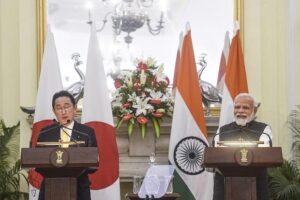

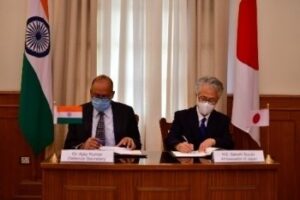
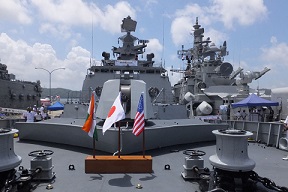
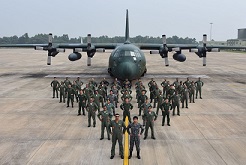



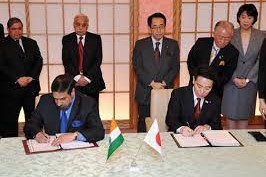

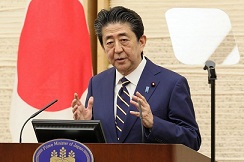
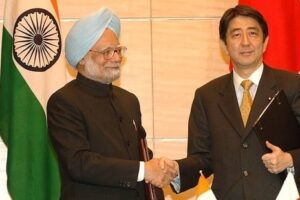
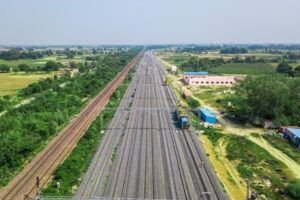
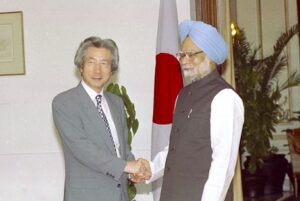
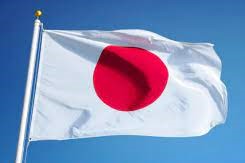
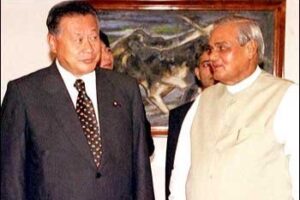
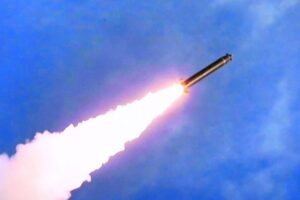




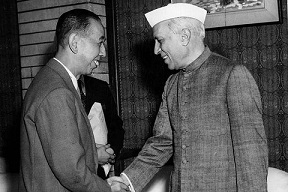



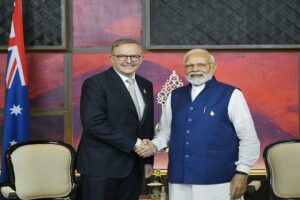



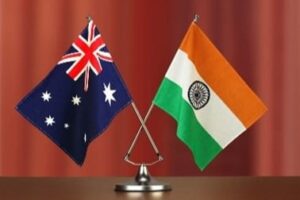
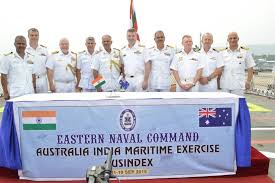

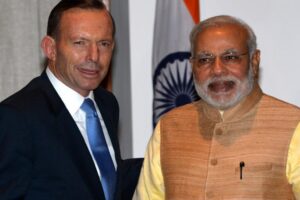





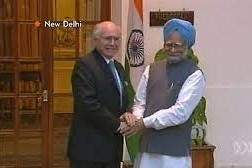
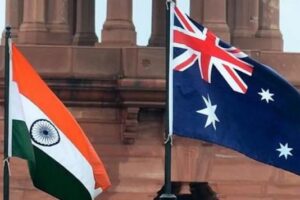


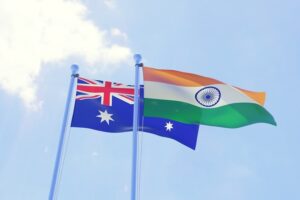

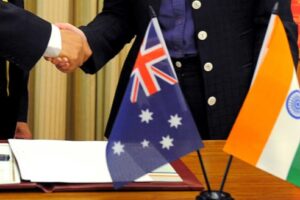

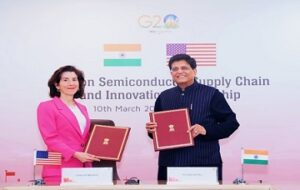
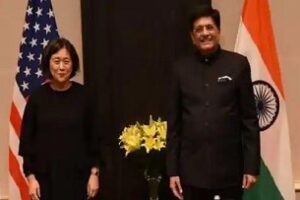
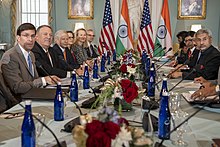



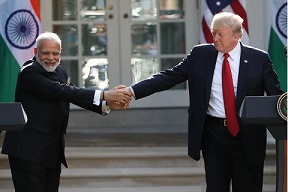
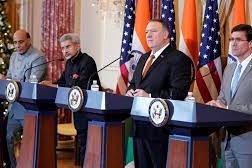

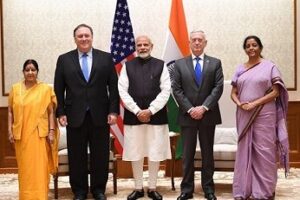
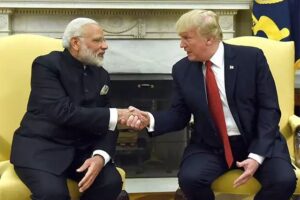
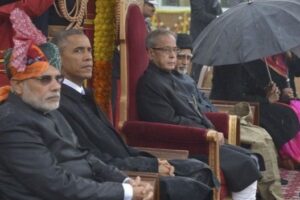

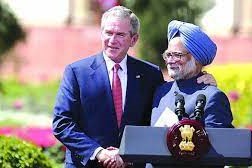
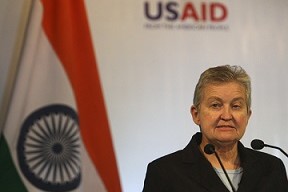
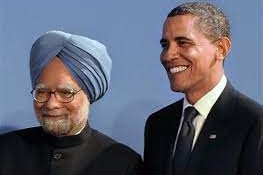
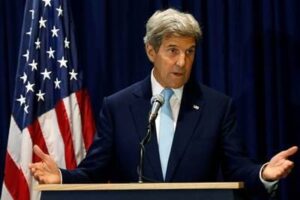

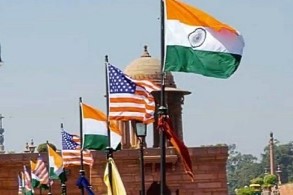
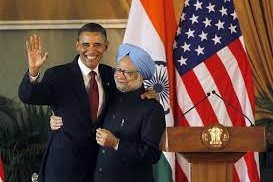


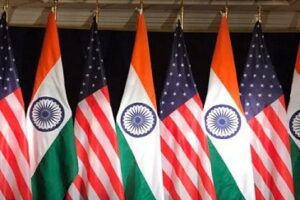
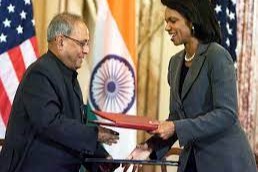

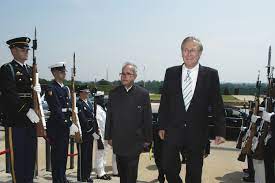


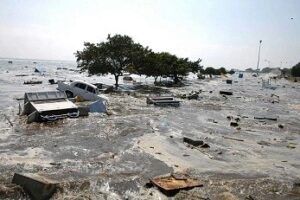

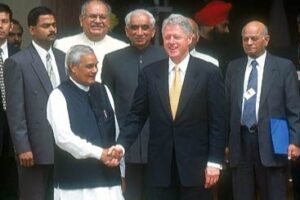
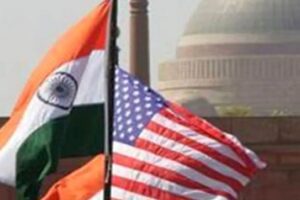
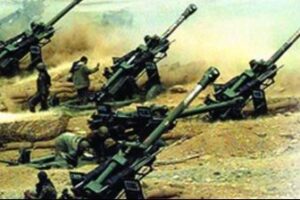
 onducted a total of five underground nuclear tests, breaking a 24-year self-imposed moratorium on nuclear testing. Pakistan followed, claiming 5 tests on May 28, 1998, and an additional test on May 30. The unannounced tests created a global storm of criticism, as well as a serious setback for decades of U.S. nuclear nonproliferation efforts in South Asia. On May 13, 1998, President Clinton imposed economic and military sanctions on India, mandated by Section 102 of the Arms Export Control Act (AECA), and applied the same sanctions to Pakistan on May 30. Some effects of the sanctions on India included: termination of $21 million in FY1998 economic development assistance; postponement of $1.7 billion in lending by the International Financial Institutions (IFI), as supported by the Group of Eight (G-8) leading industrial nations; prohibition on loans or credit from U.S. banks to the government of India; and termination of Foreign Military Sales under the Arms Export Control Act. Humanitarian assistance, food, or other agricultural commodities are excepted from sanctions under the law.
onducted a total of five underground nuclear tests, breaking a 24-year self-imposed moratorium on nuclear testing. Pakistan followed, claiming 5 tests on May 28, 1998, and an additional test on May 30. The unannounced tests created a global storm of criticism, as well as a serious setback for decades of U.S. nuclear nonproliferation efforts in South Asia. On May 13, 1998, President Clinton imposed economic and military sanctions on India, mandated by Section 102 of the Arms Export Control Act (AECA), and applied the same sanctions to Pakistan on May 30. Some effects of the sanctions on India included: termination of $21 million in FY1998 economic development assistance; postponement of $1.7 billion in lending by the International Financial Institutions (IFI), as supported by the Group of Eight (G-8) leading industrial nations; prohibition on loans or credit from U.S. banks to the government of India; and termination of Foreign Military Sales under the Arms Export Control Act. Humanitarian assistance, food, or other agricultural commodities are excepted from sanctions under the law. 
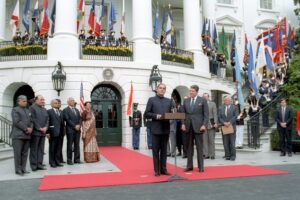



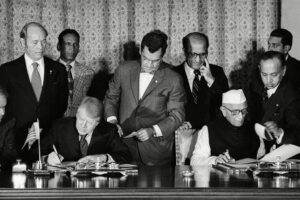
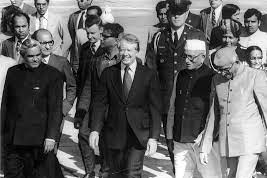

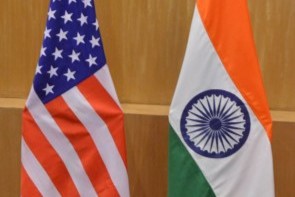



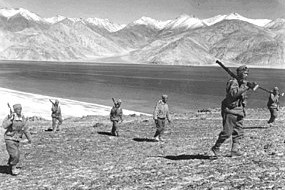



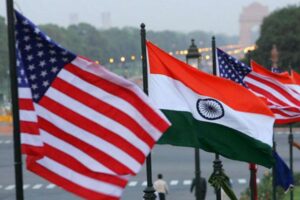
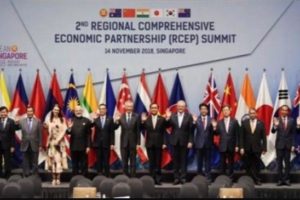 The first ministerial level meeting of QUAD was held on the sidelines of the United Nations General Assembly in New York. Before this, the QUAD had
The first ministerial level meeting of QUAD was held on the sidelines of the United Nations General Assembly in New York. Before this, the QUAD had AusIndEx is an exercise between India and Australia which was first held in 2015.The Australian
AusIndEx is an exercise between India and Australia which was first held in 2015.The Australian 



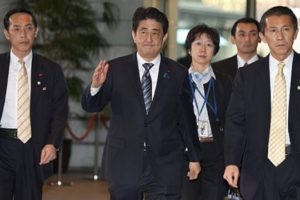

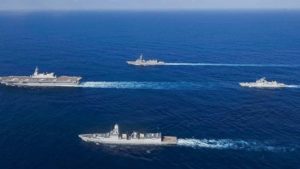

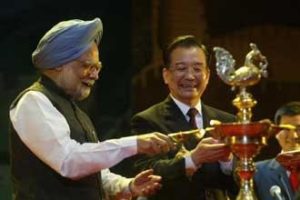 On recommendations of the Japanese government, the four countries met at Manila, Philippines for ASEAN Regional Forum (ARF) originally, but also ended up having a meeting of what we call the first meeting of four nation states on issues of
On recommendations of the Japanese government, the four countries met at Manila, Philippines for ASEAN Regional Forum (ARF) originally, but also ended up having a meeting of what we call the first meeting of four nation states on issues of 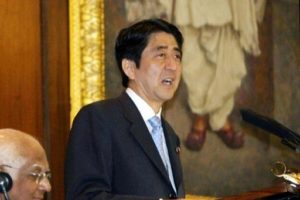 On his official visit to India, Japanese PM Mr. Shinzo Abe reinforced the ties of two nations, i.e., Japan and India with his famous speech about
On his official visit to India, Japanese PM Mr. Shinzo Abe reinforced the ties of two nations, i.e., Japan and India with his famous speech about  In 2007, Japanese President Shinzo Abe resigned from his post citing health reasons. This had a significant impact on QUAD as he was the architect & advocate of QUAD. His successor, Yasuo Fukuda, did not take up QUAD with such zeal leading to dormancy of the forum. (
In 2007, Japanese President Shinzo Abe resigned from his post citing health reasons. This had a significant impact on QUAD as he was the architect & advocate of QUAD. His successor, Yasuo Fukuda, did not take up QUAD with such zeal leading to dormancy of the forum. (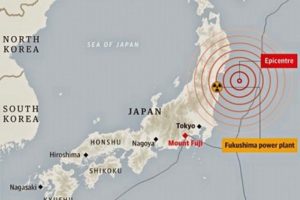 Japan earthquake and tsunami of 2011, also called Great Sendai Earthquake or Great Tōhoku Earthquake, was a 9.0 magnitude earthquake which struck below the floor of the Western Pacific at 2:49 PM. The powerful earthquake affected the northeastern coast of Honshu, Japan’s main island, and also initiated a series of large tsunami waves that devastated coastal areas of Japan, which also led to a major nuclear accident. Japan received aid from India, US, Australia as well as other countries. US Navy aircraft carrier was dispatched to the area and Australia sent search-and-rescue teams.
Japan earthquake and tsunami of 2011, also called Great Sendai Earthquake or Great Tōhoku Earthquake, was a 9.0 magnitude earthquake which struck below the floor of the Western Pacific at 2:49 PM. The powerful earthquake affected the northeastern coast of Honshu, Japan’s main island, and also initiated a series of large tsunami waves that devastated coastal areas of Japan, which also led to a major nuclear accident. Japan received aid from India, US, Australia as well as other countries. US Navy aircraft carrier was dispatched to the area and Australia sent search-and-rescue teams. 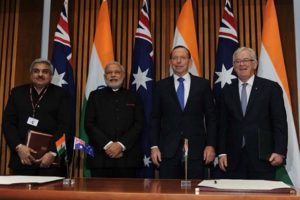 India and Australia signed the
India and Australia signed the  The India-Japan Agreement for Cooperation in the Peaceful Uses of Nuclear Energy was signed on 11 November, 2016 and came into force on 20 July, 2017 which was representative of strengthening ties between India and Japan. Diplomatic notes were exchanged between Dr. S. Jaishankar and H.E. Mr. Kenji Hiramatsu, Ambassador of Japan to India. (
The India-Japan Agreement for Cooperation in the Peaceful Uses of Nuclear Energy was signed on 11 November, 2016 and came into force on 20 July, 2017 which was representative of strengthening ties between India and Japan. Diplomatic notes were exchanged between Dr. S. Jaishankar and H.E. Mr. Kenji Hiramatsu, Ambassador of Japan to India. (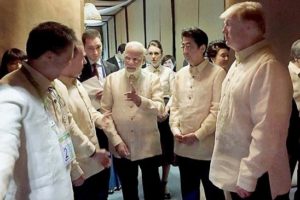 The foreign ministry
The foreign ministry The Officials of QUAD member countries met in Singapore on November 15, 2018 for consultation on regional & global issues of common interest. The main discussion revolved around connectivity, sustainable development, counter-terrorism, maritime and cyber security, with the view to promote peace, stability and prosperity in the
The Officials of QUAD member countries met in Singapore on November 15, 2018 for consultation on regional & global issues of common interest. The main discussion revolved around connectivity, sustainable development, counter-terrorism, maritime and cyber security, with the view to promote peace, stability and prosperity in the 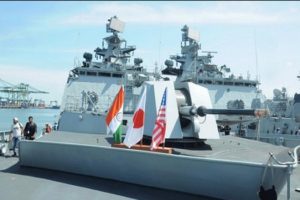 The 23rd edition of trilateral Malabar maritime exercise between India, US and Japan took place on 26 September- 04 October, 2019 off the coast of Japan.
The 23rd edition of trilateral Malabar maritime exercise between India, US and Japan took place on 26 September- 04 October, 2019 off the coast of Japan.  After the first ministerial level meeting of QUAD in September, 2019, the senior officials of US, Japan, India and Australia again met for consultations in Bangkok on the margins of the East Asia Summit. Statements were issued separately by the four countries. Indian Ministry of External Affairs said “In statements issued separately by the four countries, MEA said, “proceeding from the strategic guidance of their Ministers, who met in New York City on the sidelines of the UN General Assembly recently, the officials exchanged views on ongoing and additional practical cooperation in the areas of connectivity and infrastructure development, and security matters, including counterterrorism, cyber and maritime security, with a view to promoting peace, security, stability, prosperity in the Indo-Pacific region.”
After the first ministerial level meeting of QUAD in September, 2019, the senior officials of US, Japan, India and Australia again met for consultations in Bangkok on the margins of the East Asia Summit. Statements were issued separately by the four countries. Indian Ministry of External Affairs said “In statements issued separately by the four countries, MEA said, “proceeding from the strategic guidance of their Ministers, who met in New York City on the sidelines of the UN General Assembly recently, the officials exchanged views on ongoing and additional practical cooperation in the areas of connectivity and infrastructure development, and security matters, including counterterrorism, cyber and maritime security, with a view to promoting peace, security, stability, prosperity in the Indo-Pacific region.” US 2+2 Ministerial Dialogue was held on 18 December, 2019, in Washington DC. Secretary of State Michael R. Pompeo and Secretary of Defense Mark T. Esper will host Indian Minister of External Affairs Dr. S. Jaishankar and Minister of Defense Shri Rajnath Singh. The discussion focussed on deepening bilateral strategic and defense cooperation, exchanging perspectives on global developments, and our shared leadership in the Indo-Pacific region.The two democracies signed the Industrial Security Annex before the 2+2 Dialogue. Assessments of the situation in Afghanistan, Pakistan, Nepal, Sri Lanka, and the Indian Ocean region in general were shared between both countries. (
US 2+2 Ministerial Dialogue was held on 18 December, 2019, in Washington DC. Secretary of State Michael R. Pompeo and Secretary of Defense Mark T. Esper will host Indian Minister of External Affairs Dr. S. Jaishankar and Minister of Defense Shri Rajnath Singh. The discussion focussed on deepening bilateral strategic and defense cooperation, exchanging perspectives on global developments, and our shared leadership in the Indo-Pacific region.The two democracies signed the Industrial Security Annex before the 2+2 Dialogue. Assessments of the situation in Afghanistan, Pakistan, Nepal, Sri Lanka, and the Indian Ocean region in general were shared between both countries. (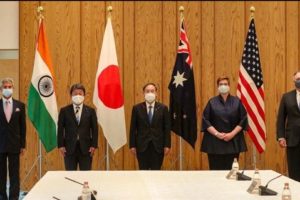 The foreign ministers of QUAD continued their discussions from the last ministerial level meeting in 2019, on 6 October, 2020. While there was no joint statement released, all countries issued individual readouts. As per the issue readout by India, the discussion called for a coordinated response to the challenges including financial problems emanating from the pandemic, best practices to combat Covid-19, increasing the resilience of supply chains, and enhancing access to affordable vaccines, medicines and medical equipment. There was also a focus on maintaining stability in the Indo-Pacific region amidst growing tensions. Australian media release mentions “We emphasised that, especially during a pandemic, it was vital that states work to ease tensions and avoid exacerbating long-standing disputes, work to counter disinformation, and refrain from malicious cyberspace activity. Ministers reiterated that states cannot assert maritime claims that are inconsistent with international law, particularly the United Nations Convention on the Law of the Sea (UNCLOS).”
The foreign ministers of QUAD continued their discussions from the last ministerial level meeting in 2019, on 6 October, 2020. While there was no joint statement released, all countries issued individual readouts. As per the issue readout by India, the discussion called for a coordinated response to the challenges including financial problems emanating from the pandemic, best practices to combat Covid-19, increasing the resilience of supply chains, and enhancing access to affordable vaccines, medicines and medical equipment. There was also a focus on maintaining stability in the Indo-Pacific region amidst growing tensions. Australian media release mentions “We emphasised that, especially during a pandemic, it was vital that states work to ease tensions and avoid exacerbating long-standing disputes, work to counter disinformation, and refrain from malicious cyberspace activity. Ministers reiterated that states cannot assert maritime claims that are inconsistent with international law, particularly the United Nations Convention on the Law of the Sea (UNCLOS).”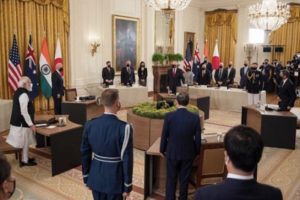 On September 24, President Biden hosted Prime Minister Scott Morrison of Australia, Prime Minister Narendra Modi of India, and Prime Minister Yoshihide Suga of Japan at the White House for the first-ever in-person Leaders’ Summit of the QUAD. The leaders released a Joint Statement which summarised their dialogue and future course of action. The regional security of the Indo-Pacific and strong confidence in the ASEAN remained on the focus along with response to the Pandemic.
On September 24, President Biden hosted Prime Minister Scott Morrison of Australia, Prime Minister Narendra Modi of India, and Prime Minister Yoshihide Suga of Japan at the White House for the first-ever in-person Leaders’ Summit of the QUAD. The leaders released a Joint Statement which summarised their dialogue and future course of action. The regional security of the Indo-Pacific and strong confidence in the ASEAN remained on the focus along with response to the Pandemic. 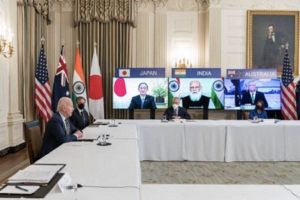 The QUAD Vaccine Partnership was announced at the first QUAD Summit on 12 March 2021 where QUAD countries agreed to deliver 1.2 billion vaccine doses globally. The aim was to expand and finance vaccine manufacturing and equipping the Indo-Pacific to build resilience against Covid-19. The launch of a senior-level QUAD Vaccine Experts Group, comprised of top scientists and officials from all QUAD member governments was also spearheaded.
The QUAD Vaccine Partnership was announced at the first QUAD Summit on 12 March 2021 where QUAD countries agreed to deliver 1.2 billion vaccine doses globally. The aim was to expand and finance vaccine manufacturing and equipping the Indo-Pacific to build resilience against Covid-19. The launch of a senior-level QUAD Vaccine Experts Group, comprised of top scientists and officials from all QUAD member governments was also spearheaded.  Although the Tsunami Core group had to be disbanded on fulfilment of its purpose, however the quadrilateral template that formed remained intact as a successful scaffolding of four countries, as stated by authors Patrick Gerard Buchan and Benjamin Rimland in their diplomatic brief about QUAD ( you can access the brief at
Although the Tsunami Core group had to be disbanded on fulfilment of its purpose, however the quadrilateral template that formed remained intact as a successful scaffolding of four countries, as stated by authors Patrick Gerard Buchan and Benjamin Rimland in their diplomatic brief about QUAD ( you can access the brief at  Secretary of State Colin Powell stated that the Core Tsunami Group was to be disbanded and folded and clubbed with the broader United Nations led Relief Operations. In a Tsunami Relief Conference in Jakarta, Secretary Powell stated that
Secretary of State Colin Powell stated that the Core Tsunami Group was to be disbanded and folded and clubbed with the broader United Nations led Relief Operations. In a Tsunami Relief Conference in Jakarta, Secretary Powell stated that 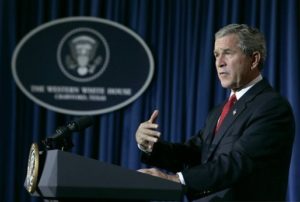 Soon after the Earthquake and Tsunami crisis, humanitarian reliefs by countries, viz., US, India, Japan, and Australia started to help the 13 havoc-stricken countries. The US initially promised $ 35 Millions in aid. However, on 29
Soon after the Earthquake and Tsunami crisis, humanitarian reliefs by countries, viz., US, India, Japan, and Australia started to help the 13 havoc-stricken countries. The US initially promised $ 35 Millions in aid. However, on 29 At 7:59AM local time, an earthquake of 9.1 magnitude (undersea) hit the coast of Sumatra, an Indonesian island. As a result of the same, massive waves of Tsunami triggered by the earthquake wreaked havoc for 7 hours across the Indian Ocean and to the coastal areas as far away as East Africa. The infamous Tsunami killed around 225,000 people, with people reporting the height of waves to be as high as 9 metres, i.e., 30 feet. Indonesia, Srilanka, India, Maldives, Thailand sustained horrendously massive damage, with the death toll exceeding 200,000 in Northern Sumatra’s Ache province alone. A great many people, i.e., around tens of thousands were found dead or missing in Srilanka and India, mostly from Andaman and Nicobar Islands of Indian territory. Maldives, being a low-lying country, also reported casualties in hundreds and more, with several non-Asian tourists reported dead or missing who were vacationing. Lack of food, water, medicines burgeoned the numbers of casualties, with the relief workers finding it difficult to reach the remotest areas where roads were destroyed or civil war raged. Long-term environmental damage ensued too, as both natural and man-made resources got demolished and diminished.
At 7:59AM local time, an earthquake of 9.1 magnitude (undersea) hit the coast of Sumatra, an Indonesian island. As a result of the same, massive waves of Tsunami triggered by the earthquake wreaked havoc for 7 hours across the Indian Ocean and to the coastal areas as far away as East Africa. The infamous Tsunami killed around 225,000 people, with people reporting the height of waves to be as high as 9 metres, i.e., 30 feet. Indonesia, Srilanka, India, Maldives, Thailand sustained horrendously massive damage, with the death toll exceeding 200,000 in Northern Sumatra’s Ache province alone. A great many people, i.e., around tens of thousands were found dead or missing in Srilanka and India, mostly from Andaman and Nicobar Islands of Indian territory. Maldives, being a low-lying country, also reported casualties in hundreds and more, with several non-Asian tourists reported dead or missing who were vacationing. Lack of food, water, medicines burgeoned the numbers of casualties, with the relief workers finding it difficult to reach the remotest areas where roads were destroyed or civil war raged. Long-term environmental damage ensued too, as both natural and man-made resources got demolished and diminished.
No responses yet